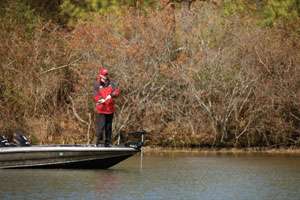
For Kevin VanDam, early winter is the time to watch the temperature gauge and gear up for serious spinnerbait action. No matter the species — largemouth, smallmouth or spots — big spinnerbaits lure big bass in fall and winter.
"The ideal water conditions are 45 to 55 degrees," says the 2008 Toyota Tundra Bassmaster Angler of the Year. "It's my favorite window for spinnerbait fishing from Michigan to Missouri. A big spinnerbait is great this time of year."
Falling water temperatures slow fish down. To KVD, the key to cold weather spinnerbait fishing, shallow or deep, is to s-l-o-w down, too.
SELECTION
His spinnerbait of choice is the Kevin VanDam Spinnerbait model he designed for Strike King (Bass Pro Shops). It is pre-rigged with a Mustad Ultra Point Bleeding trailer hook.
"This is one time of year I don't trim the skirts and I don't bend the blades, but I may upsize the rear blade, going up to a No. 6 or 7 on occasion to slow it down," he says. "I want a big profile. Bass are feeding mostly on shad, and the spinnerbait is a great imitation of a big baitfish."
Forage and water clarity determine skirt color. In clear water, shad-based lakes, "natural shad" is his usual choice. For stained or dirty water, chartreuse and white is a hard color combo to beat. Among his favorites are the bluegill and "smokey shad" patterns he designed for Strike King.
For fish near the bank, he often prefers a 1/2-ounce spinnerbait with tandem No. 3.5 and 5 willow blades. Fishing water deeper than 8 feet, he fishes a single willow blade.
"But a lot depends on water clarity," says the two-time Classic champ. "If it's dirty, I'll use a big Colorado or Indiana blade bait. In clear to stained water, it's a double willow or willow plus Colorado. In any case, it's bigger blades to slow the bait down and keep it higher in the water column."
Fishing deep, especially deep weedlines in northern natural lakes, may call for a different approach, he quickly qualifies. For those waters, he slow rolls a 3/4-ounce spinnerbait with a No. 5 willow or double willow, often getting deep into the surviving grass.
THE HIGHLANDER
The big spinner blades shine on highland reservoirs such as the Ozark waters of Bull Shoals, Beaver Lake and Table Rock.
"Sometimes I'm slow rolling deeper water, but a lot of times I'm slowly working it — almost waking it — at the surface," he explains. "I hold the rod tip up and keep the bait in the top foot or so or even bulging the surface."
He keeps on the lookout for signs of baitfish on his sonar unit or at the surface. Shad — especially gizzard shad — are often tight to the shoreline.
Prime targets are points, chunk rock banks and laydowns. Steep laydowns are particularly attractive as he slow rolls the bait from the base of the trunk near shore down to the tops of the fallen trees in deep water. He fishes steep rocky points similarly.
"I throw shallow and bring the bait back, fishing at about a 45-degree angle down the bank," explains VanDam. "You are trying to figure out the zone the fish are coming from, whether it's close to the bank or out deeper. Often it changes during the day. They can go deeper or move up. If clarity is good, a fish will come out of 15 feet of water to hit. Always it's a slow presentation."
BIG IS BETTER
Big slow spinnerbaits offer a multitude of advantages in cold water.
"You can cover a lot of water," says KVD. "And you can fish all forms of cover — docks, grass, laydowns. It's very efficient. It has a lot of drawing power. And your hookup ratio is good."
And one more …
"I see other guys catching fish on lipless crankbaits and other baits, particularly on the Ozark lakes, but they aren't catching the size I get on the spinnerbait," he says. "It catches the big ones."
GEAR AND RETRIEVAL TIPS
KVD believes that the tools he uses for this spinnerbait technique are just as important as understanding when to throw the blades. Here are his choices: Quantum Energy PT rod (6-foot, 10-inch or 7-foot, medium heavy), Quantum Tour Edition PT 1170 reel, and Bass Pro XPS line (20-pound monofilament for most applications; fluorocarbon for deep).
The last piece to your cold water spinnerbait puzzle may be in your retrieve.
"I shake the rod tip a lot during my retrieve," says VanDam. "Every 5 feet or more, I shake the rod tip and make the skirt flare. That's really important to trigger strikes."
As water drops near the 45-degree mark, he finds a lift-drop yo-yo retrieve to be "really efficient," particularly on steep ledges and bluff banks. He sticks with single blade spinnerbaits for this approach — an Indiana blade for water less than 8 feet, and a single willow for deeper water.




